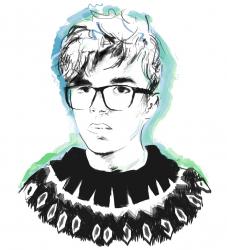It is no coincidence, argues Egill Sæbjörnsson, a Berlin-based conceptual artist and Iceland’s representative at the 57th Venice Biennale, that the country’s busiest years for tourism have accompanied a record-breaking rise in the number of “lost and dead people.” Trolls are not so easily swayed by foreign currency, after all.
The Icelandic Pavilion at the Venice Biennale has been lauded—and criticised—for its provocative contributions to the festival in the past. 2015 saw Venice officials shut down Swiss-Icelandic artist Christoph Büchel’s conversion of a deconsecrated Catholic church into a working mosque—a controversy which arguably only reinforced the project’s critique of institutionalised prejudice.
This year’s Pavilion exhibition is, at first glance, less wilfully provocative than the mosque project. Upon a closer look, however, it becomes clear that Egill’s contribution to the Biennale, ‘Out of Controll in Venice’, asks perhaps even more difficult questions about the nature of authorship and the relationship between the real and the imaginary. That’s thanks to the creative “input” of two technicolour trolls-turned-artists, Ūgh and Bõögâr.
“Even Egill, who believes that everything is connected, that art pervades life (and vice versa) and holds humanity together, that all boundaries are imaginary, even he is repeatedly surprised by the trolls’ tricks, brainwaves, and talents,” remarks Stefanie Böttcher, Director of Kunsthalle Mainz and the curator of the Icelandic Pavilion. “Ūgh and Bõögâr are literally overwhelming.”

Out of controll
Claiming to straddle the boundaries between fiction and nonfiction, reality and imagination, real friends and imaginary ones, Ūgh and Bõögâr first “met” Egill in 2008. Instead of eating him, Egill claims, the trolls decided to become Egill’s friends and share his art studio. The mixed media projects Egill has developed in the trolls’ name span music (a thirteen-track howling twig-funk album), sculpture (gigantic screaming troll heads scattered across Venice), fashion (in collaboration with Eygló, winner of Grapevine’s Fashion Design of the Year 2016), and even virtual reality. They have since travelled to Venice by foot from Berlin, which, owing to their size, only took five seconds—and established a “living café,” where they talk about their lives, thoughts, and experiences through light, sound, and animation.
Using this array of media and technology to explore binaries and cultural cognitive dissonance, ‘Out of Controll’ takes cues from Egill’s earlier work in mixing video projection with sculpture and painting. He describes his technique as a “technological continuation of painting,” underpinned by his belief that all art is alive. Björg Stefánsdóttir, the director of the Icelandic Art Centre, remarks that “the Icelandic Pavilion has frequently been a venue for dissolving social constructs—whether they be ideologies, nationalist sentiments, or the myth of the artist. This tradition has been taken to a whole new level with ‘Out of Controll in Venice’, where all social constructs are annihilated as we let the unchecked creative powers of Ūgh and Bõögâr take over.”
As one steps through the long strands of troll hair guarding the exhibition entrance, the tactile and visual manifestations of Ūgh and Bõögâr at the Pavilion might do more than just take over—these multitudinous, hyper-real trolls from the Icelandic countryside are threatening to sink Venice once and for all.

Buy subscriptions, t-shirts and more from our shop right here!


















